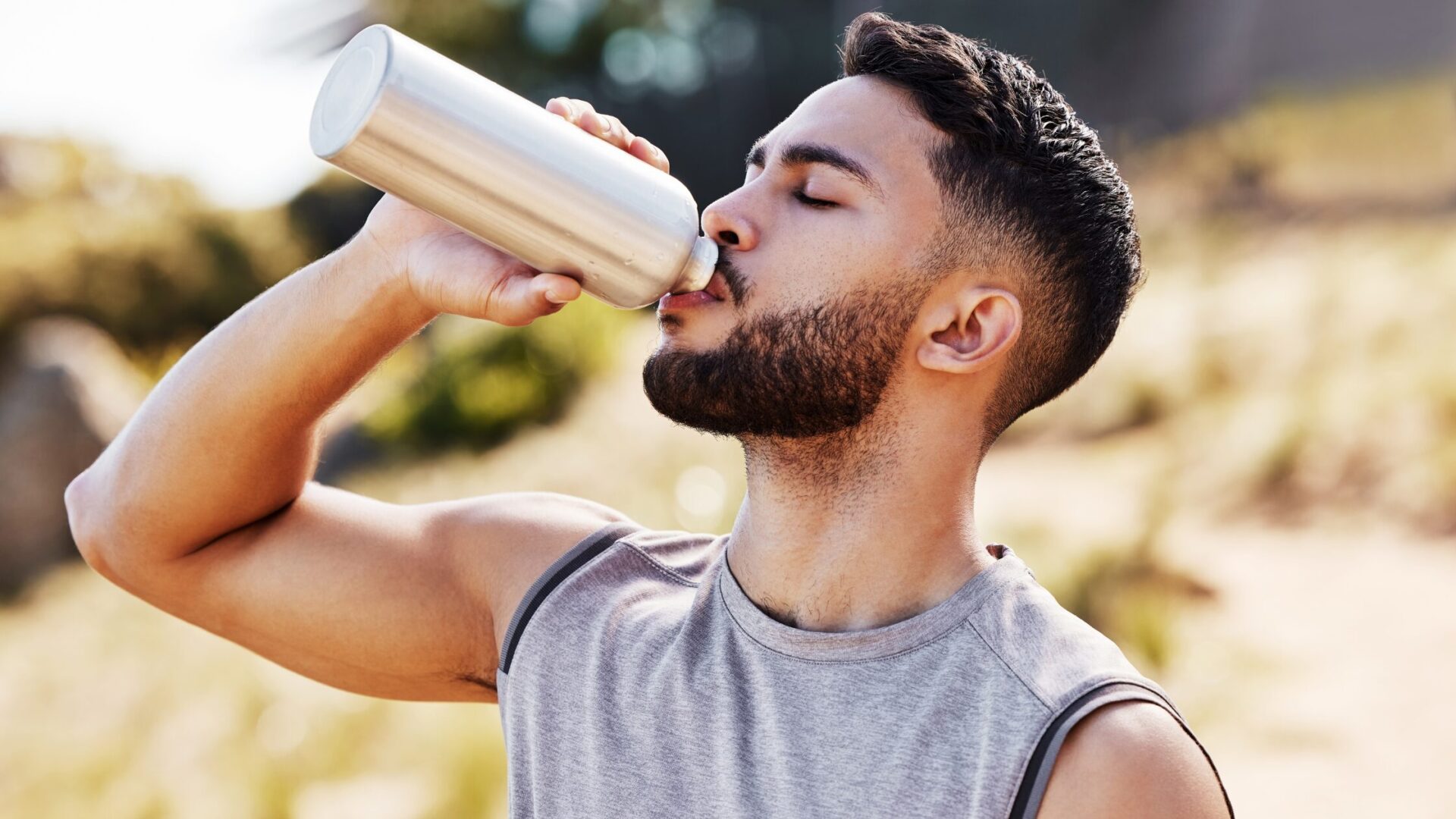Top 10 Workouts for Better Mental Health In 2024
Introduction: The Link Between Exercise and Mental Well-being
Regular physical activity is much more than a tool for maintaining physical fitness—it’s also an essential component of mental health care. Engaging in consistent workouts can act as a natural combatant against stress, anxiety, and depression, leveraging the body’s own endorphins to boost mood and mental clarity. The key, however, lies in selecting exercises that not only challenge the body but also promote feelings of achievement and joy. Tailoring your workout routine to fit your personal needs can transform it from a chore into a revitalizing break from the stresses of daily life.
- Hormonal Harmony: Exercise induces the release of feel-good hormones like endorphins and serotonin.
- Stress Relief: Physical exertion has been shown to lower cortisol levels, reducing stress.
- Cognitive Clarity: Engaging in workouts can improve cognitive functions, enhancing focus and memory.
- Emotional Balance: Regular activity can help regulate mood swings and contribute to emotional stability.
- Sleep Quality: Consistent exercise routines are often associated with improved sleep patterns.
Understanding and harnessing this mind-body connection can lead to a more harmonious state of being, demonstrating that the right workouts are not only beneficial but vital for mental health.
The Science of Exercise and Mental Health
Research and expert opinions unanimously highlight the profound impact that physical activity has on mental well-being. Here are some scientifically-backed ways in which exercise enhances mental health:
- Neurogenesis and Neuroplasticity: Studies have shown that regular physical activity promotes the growth of new neurons and aids in neuroplasticity, which is the brain’s ability to adapt and reorganize itself (Ratey, J., 2008). This results in better mental resilience and an improved capacity for learning.
- Reduction of Inflammatory Markers: Exercise is known to reduce inflammation in the body, and inflammation is linked to mood disorders (Berk, M., et al., 2013). Reduced inflammation may lead to decreased symptoms of depression and anxiety.
- Stress Response Modulation: Physical exertion can aid in regulating the body’s stress response, making individuals more equipped to manage stress proactively (Childs, E., & de Wit, H., 2014).
- Enhanced Self-Esteem: Regular engagement in exercise has been tied to improvements in self-esteem and self-image, which are crucial components of mental health (Sonstroem, R. J., & Morgan, 1989).
Embracing an active lifestyle is not just a means to improve physical fitness but a scientifically-supported path to bolster mental fortitude and overall psychological wellness.
Common Mental Health Benefits of Exercise
Stress Reduction
Regular physical activity is a potent stress-reducer. Engaging in exercise stimulates the production of endorphins, the brain’s feel-good neurotransmitters, which act as natural painkillers and mood elevators. Additionally, focusing on a workout can be a form of meditation in motion, helping reduce the day’s stresses and allowing a fresh perspective on problems. The Anxiety and Depression Association of America (ADAA) reports that around 14% of people use regular exercise to cope with stress.
Improved Mood
Exercising regularly can improve your mood and decrease feelings of depression, anxiety, and stress. It is not only a short-term fix; over time, physical activity helps increase the production of neurotransmitters that promote mental well-being, such as serotonin and norepinephrine. For more information, the Mayo Clinic provides insight on exercise’s effects on mood and depression.
Anxiety Relief
Physical activity can also help with anxiety relief. By concentrating on the body’s movements, an individual may find that they are distracted from the day’s irritations and concerns, allowing for a calmness of mind. Exercises such as jogging, swimming, cycling, walking, and dancing have been proven to reduce anxiety and improve mental health. Harvard Health Publishing has explored this connection, highlighting the benefits that come with regular physical activity.
Enhanced Cognitive Function
Working out doesn’t just strengthen your muscles—it also enhances the brain’s function. Exercise improves cognitive function related to memory, concentration, and creativity. Consistent physical activity boosts brain health, which is vital at every age and is something that can also have significant impacts on academic performance and productivity. The Centers for Disease Control and Prevention (CDC) provides extensive guidelines on how much exercise is needed to help improve cognition. You can also refer to this article for more detailed information! Best Fitness Tips to Maintain a Healthy Life.
Top 10 Workouts for Mental Health
- Yoga: Yoga combines physical postures, breathing exercises, and meditation to promote relaxation and stress reduction. It enhances mental health by reducing anxiety and improving mood. For beginners, focusing on gentle poses and breathing can make it accessible, while advanced practitioners can explore more complex asanas and longer meditation sessions.
- Running: Running is a powerful aerobic exercise known to combat depression and anxiety by releasing endorphins. Beginners may start with brisk walking and gradually incorporate interval running, while experienced runners can increase distance and intensity for added mental health benefits.
- Swimming: Swimming is a low-impact exercise ideal for reducing stress and promoting a meditative state of mind. It’s suitable for all fitness levels—those new to swimming can start with shorter laps or water walking, while seasoned swimmers can challenge themselves with long-distance swims or timed sprints.
- Cycling: Whether outdoor or stationary, cycling boosts endorphin levels which in turn improves mood and decreases stress levels. Beginners can start with lower resistance and shorter durations, and as fitness improves, gradually increase both speed and resistance.
- Strength Training: Lifting weights or using resistance bands can improve self-esteem and cognitive function. Beginners should start with lighter weights and focus on form, while those more experienced can try heavier weights and more complex lift sequences for additional cognitive challenge.
- Pilates: Pilates improves core strength and stability while also reducing anxiety and boosting brainpower. Beginners can start with basic courses that focus on form and breathing techniques, whereas more experienced individuals may explore advanced moves that challenge both body and mind.
- Dance: Dance is not only a fun aerobic workout that releases endorphins but also encourages creative expression. Beginners can start with less intensive dance styles or classes, while more advanced dancers might try complex choreography or faster-paced dance styles.
- Hiking: Walking in nature while hiking offers a tranquil environment, which helps reduce stress and improve mood. Beginners can choose flat trails and shorter distances, while more advanced hikers might seek out challenging terrain and longer treks.
- Boxing: Boxing is an excellent stress-buster and confidence builder. Start with non-contact drills like shadow boxing and basic footwork for beginners, and progress to sparring and more technical combinations for those with a higher fitness level.
- Tai Chi: Known for its gentle movements and focus on breath control, Tai Chi reduces stress and anxiety. Suitable for every fitness level, beginners can start with simple sequences and as they progress, explore longer forms and integrate Qi Gong breathing techniques for additional mental relaxation.
1- Yoga and Mindfulness
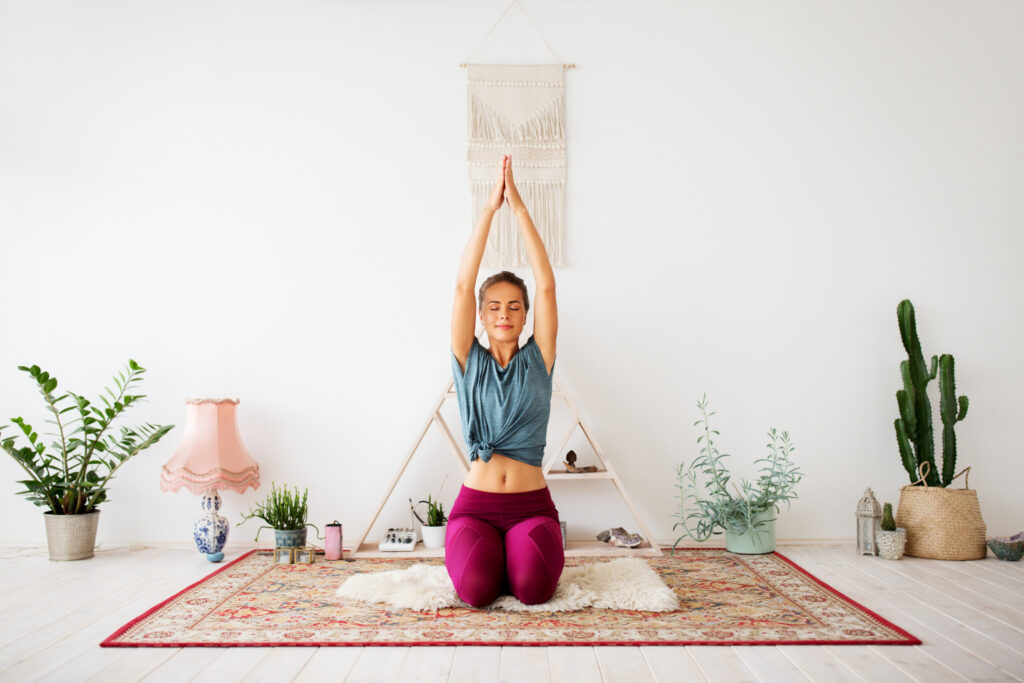
Yoga transcends physical exercise, offering profound mental health benefits through the promotion of mindfulness and stress reduction. The practice encourages individuals to focus on the present moment, align breathing with movement, and cultivate a sense of inner peace. It is the mindfulness aspect of yoga that contributes significantly to stress alleviation, as it allows practitioners to break away from the cyclical patterns of anxious or negative thoughts. Different styles of yoga cater to various experience levels and objectives:
- Hatha Yoga is ideal for beginners, comprising a slower pace that emphasizes basic postures and breathwork—a perfect entry point for those seeking to ease anxiety and stress.
- Vinyasa Yoga involves a more dynamic flow of postures and may suit those looking for a meditative practice that also provides a moderate physical workout.
- Restorative Yoga uses props to support the body in poses held for longer durations, facilitating deep relaxation and stress release, which is beneficial for all levels of practitioners.
- Ashtanga Yoga offers a rigorous sequence of poses that can serve as a therapeutic tool for stress management in those who are more experienced and seek a physically demanding practice to channel their energies.
- Kundalini Yoga combines postures, breathing techniques, and mantras to foster mental clarity and emotional calm, fitting for individuals who are interested in the spiritual aspects of mindfulness.
Each style serves to enhance the connection between mind and body, fostering resilience against stress and improving overall mental well-being.
2- Aerobic Exercises and Mental Well-being
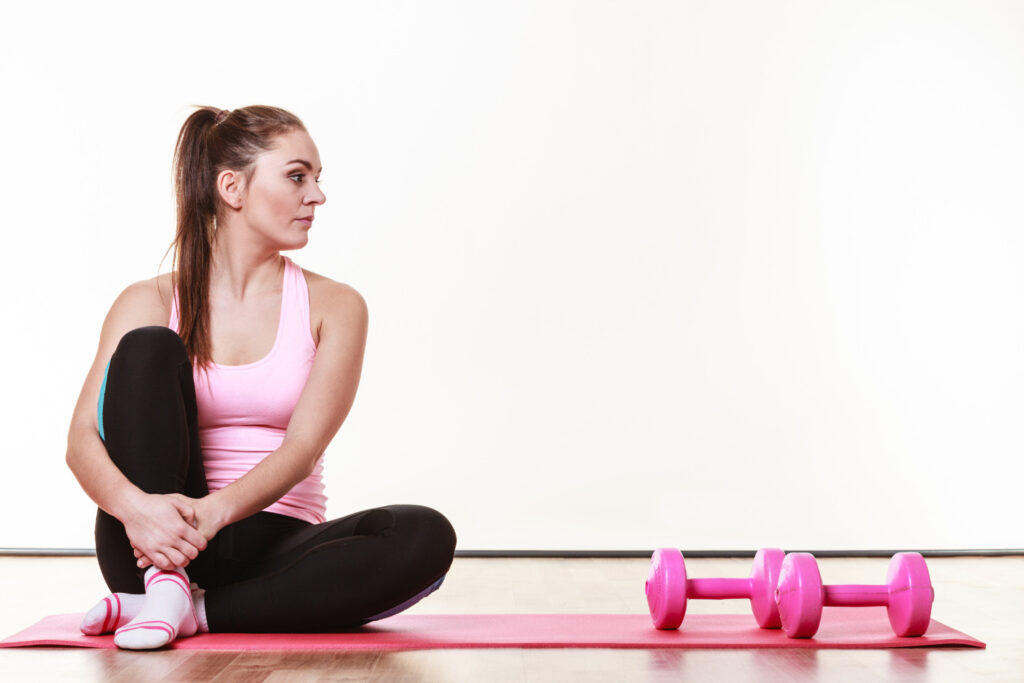
Aerobic exercises are pivotal in promoting mental health by improving mood and decreasing feelings of anxiety. Through the increase of blood circulation and the balance of the body’s natural stress hormones, these activities work wonders for psychological wellness.
- Enhanced Mood: Aerobic exercises trigger the release of endorphins, often referred to as the body’s natural mood lifters. For example, the “runner’s high” that many long-distance runners experience is largely due to this endorphin surge.
- Reduced Anxiety: Engaging in rhythmic aerobic activities such as running, swimming, or cycling can lead to a meditative state, helping to calm the mind, as explained in Harvard Health Publishing.
- Stress Relief: Activities that elevate the heart rate, improve blood flow to the brain, and encourage the production of norepinephrine, a neurotransmitter that can moderate the brain’s stress response, as outlined by ADAA.
- Improved Sleep: Regular aerobic exercise can contribute to more sound and restful sleep, which is closely linked to stress and anxiety levels. Better sleep equates to better mood and reduced anxiety, which Sleep Foundation navigates in detail.
- Increased Confidence: Meeting exercise goals or milestones, be it running a new personal best time or cycling a longer distance, naturally enhances self-esteem, which in turn can decrease feelings of anxiety, as per insights from APA.
These benefits highlight the importance of incorporating aerobic exercises into one’s routine for mental health upkeep. Whether indoors or outdoors, solo, or in group settings, these activities can be adapted to fit any lifestyle and fitness level.
Practical Tips for Incorporating Aerobic Exercise
Incorporating aerobic exercise into a daily routine can seem daunting, but with some strategic planning and consideration of personal preferences, it can become an enjoyable and sustainable aspect of daily life.
Establishing a Routine
- Set Realistic Goals: Begin by setting achievable exercise targets that align with your current fitness level and schedule. Starting with modest goals can help build momentum and confidence.
- Consistency Over Intensity: Focus on maintaining a consistent workout schedule rather than intense, sporadic sessions. Even a 10-minute brisk walk each day can be beneficial.
- Morning Motivation: Kickstart your day with a morning exercise routine to boost your metabolism and energy levels throughout the day.
- Lunch Break Walks: Utilize lunch breaks for quick walks. This not only aids in digestion but also provides a mental reset for the afternoon.
- Family Involvement: Make exercise a family activity—go for bike rides, play soccer in the yard, or have dance-offs in your living room.
Overcoming Barriers
- Activity Variation: Keep your routine fresh and exciting by varying your activities. Alternate between walking, jogging, swimming, or group fitness classes to avoid monotony.
- Indoor Alternatives: Bad weather shouldn’t be an obstacle. Dance to music, use a jump rope, or follow online workout videos when outdoor conditions are unfavorable.
- Making It Social: Recruit a workout buddy or join a community sports league. Social engagement can make exercises more enjoyable and provide motivational support.
- Track Progress: Use a journal or an app to track your aerobic exercises, which can be motivating and help you recognize your accomplishments over time.
- Non-Gym Options: Remember that a gym membership is not the only way to get fit. Explore community parks, local trails, or community center classes for economical and accessible alternatives.
3- Strength Training: Enhancing Self-Esteem and Combating Depression
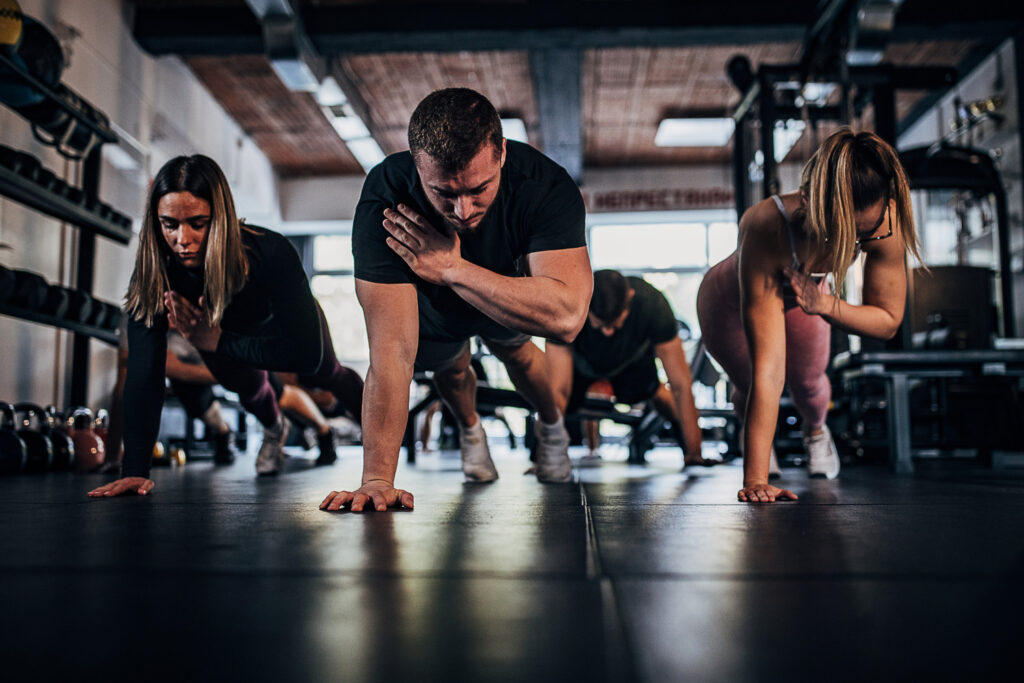
Strength training, often associated with building muscle and enhancing physical prowess, also plays a significant role in improving self-esteem and mitigating symptoms of depression. Its impact on mental health is substantiated by multiple studies revealing how it positively alters brain chemistry.
- Empowerment Through Progress: As individuals observe their strength increasing over time, they feel a growing sense of accomplishment and self-worth. This progress can be a profound source of intrinsic motivation and self-empowerment.
- Neurochemical Benefits: Lifting weights has been shown to reduce the levels of cortisol, the body’s stress hormone, and increase the production of endorphins, which are natural mood lifters. This biochemical change aids in tempering feelings of depression.
- Improved Brain Function: Strength training has been linked to the enhancement of cognitive function, which can alleviate depressive symptoms. Exercises like weightlifting stimulate the release of brain-derived neurotrophic factor (BDNF), playing a pivotal role in brain health.
- Body Image and Confidence: As physical appearance improves with muscle tone and strength, many individuals experience an increase in body confidence, which is inextricably linked to self-esteem and mental well-being.
- Social Support Structures: Engaging in strength training at gyms or group classes can also foster a sense of community and support, reducing feelings of isolation that often accompany depression.
Basic Strength Training Exercises for Beginners
Introducing strength training into your fitness regimen need not be intimidating. Below are some beginner-friendly exercises that build foundational strength without requiring complex equipment or techniques.
Bodyweight Exercises
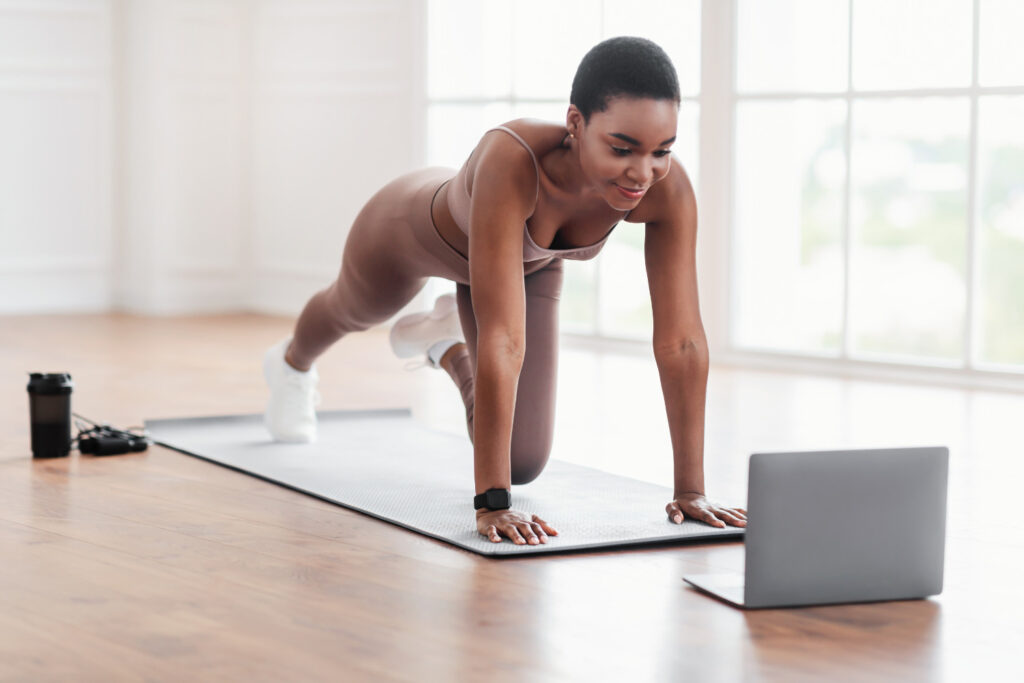
- Squats: Stand with feet shoulder-width apart, bend knees, and lower your body as if sitting back into a chair. Keep your back straight, and then return to standing.
- Push-Ups: Begin with hands and toes on the floor, hands slightly wider than shoulder-width, and lower your body until your chest almost touches the floor. Push back up to the starting position.
- Lunges: Step forward with one leg and lower your hips until both knees are bent at about a 90-degree angle. Make sure your front knee is directly above your ankle, then return to the starting position. Alternate legs.
- Planks: Lie face down, then prop yourself up on your forearms and toes, keeping your body in a straight line from shoulders to heels. Hold this position.
Resistance Band Exercises

- Band Pull-Aparts: Hold a resistance band in front of you with both hands, arms extended. Pull the band apart by bringing your shoulder blades together. Return to the starting position.
- Banded Leg Press: Sit on the floor with legs extended, loop a band around your feet and hold the ends. Bend your knees to bring them toward your chest, then extend your legs again.
- Bicep Curls: Stand on a band, hold the other end with both hands, and perform bicep curls by pulling your hands towards your shoulders.
- Tricep Extensions: Hold the band overhead and secure one end behind your back. Extend your arms upward, pulling the band taut, and then lower back down.
Free Weights Exercises

- Dumbbell Shoulder Press: Sit or stand with a dumbbell in each hand at shoulder height. Press the weights upward until your arms are extended overhead, then lower back to shoulder height.
- Dumbbell Rows: Bend forward at the waist with a dumbbell in each hand. Pull the dumbbells towards your waist, keeping your back straight, then return to the starting position.
- Hammer Curls: Stand with a dumbbell in each hand, palms facing your torso. Curl the weights up to shoulder height while keeping your palms facing in, then lower slowly.
4- High-Intensity Interval Training (HIIT): Mood Enhancement and Stress Relief

High-Intensity Interval Training, commonly known as HIIT, is a potent workout modality known for its efficiency in enhancing mood and alleviating stress. By alternating between bursts of intense activity and fixed periods of less-intense exercise or complete rest, HIIT causes rapid fluctuations in heart rate which can produce endorphins, also referred to as the body’s natural ‘feel-good’ hormones. These endorphins contribute to an improvement in mood shortly after exercise, delivering a ‘runner’s high’ without the need for prolonged workouts. Moreover, the concentration required during the high-intensity phases of HIIT can serve as a form of mental ‘time out’, allowing individuals to detach from daily stressors and refocus their minds on their physical movements, which acts as a meditative and restorative practice.
5- Pilates: Sharpening Mental Focus and Easing Anxiety

Pilates is not only a physical exercise regimen but also a mental and emotional balancer. Its practice is known for enhancing mental focus and reducing symptoms of anxiety through a series of controlled movements and breathing techniques:
- Concentration on Core Techniques: Pilates demands attention to the precision of movements, which directs the mind to focus on body mechanics and positioning, thereby fostering an improved sense of mental clarity and concentration.
- Breath Regulation: The Pilates methodology emphasizes regulated, mindful breathing which helps in reducing anxiety. This focused breathing pattern can promote a sense of calm and act as a tool for stress management.
- Mind and Body Connection: Through controlled movement Pilates strengthens the mind-body connection, leading to greater awareness and a more tranquil state of mind, which helps in diminishing feelings of anxiety.
- Stress Reduction: Engaging in the steady, flowing movements of Pilates can reduce physical and mental stress, similar to the effects of a dynamic moving meditation.
- Improved Sleep Patterns: Regular Pilates practice has been shown to improve sleep quality, which is crucial for mental health and in alleviating anxiety.
6- Dance Fitness: Boosting Mood and Mental Agility
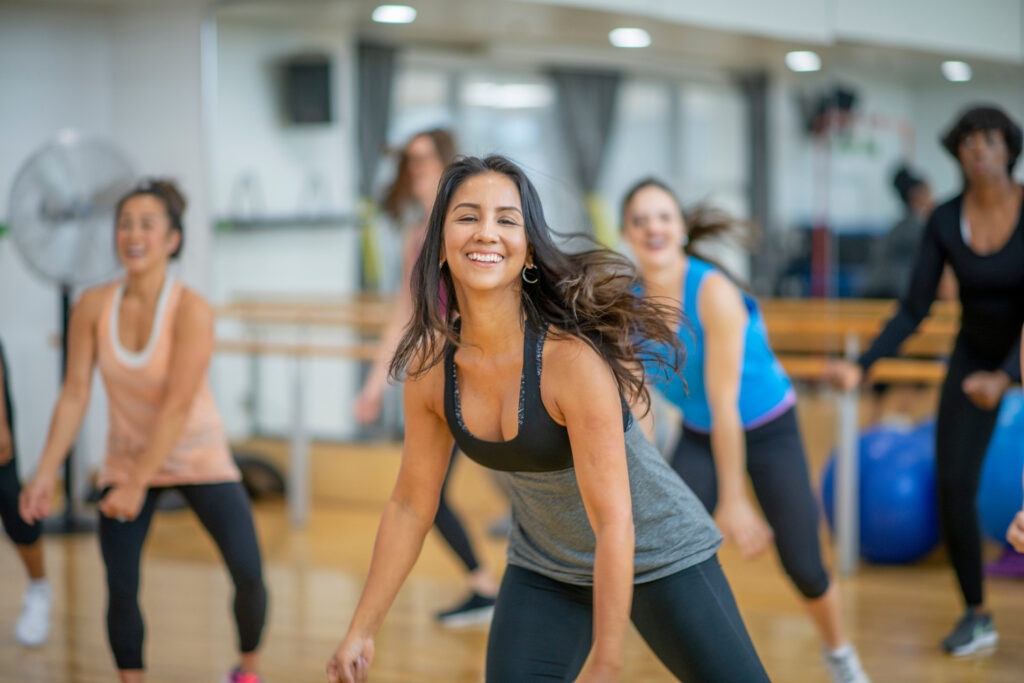
Dance fitness is not only an entertaining and vibrant way to stay active, but it also holds considerable benefits for mental health and cognitive functions. This form of exercise combines upbeat music with choreographed dance moves, creating a lively atmosphere that naturally elevates the spirit and encourages a positive mood. Here’s how dance fitness can play a role in boosting mental wellness:
- Elevated Endorphin Levels: Like other forms of exercise, dance increases the production of endorphins, the body’s natural mood lifters, often leading to an energized and euphoric post-workout feeling.
- Stress Relief: Immersing oneself in rhythm and movement can be an effective stress reliever, as the mind focuses on dance steps and patterns, redirecting attention away from daily worries and triggers.
- Cognitive Function: Learning and remembering dance routines can enhance memory, coordination, and spatial awareness, thereby improving overall mental agility.
- Social Interaction: Often practiced in groups or classes, dance fitness provides a sense of community and social engagement, which can be vital for emotional support and combating loneliness.
- Self-Expression: The expressive nature of dance allows individuals to convey emotions through movement, providing an emotional release and contributing to greater psychological well-being.
7- Outdoor Activities: Nurturing Mental Health and Community
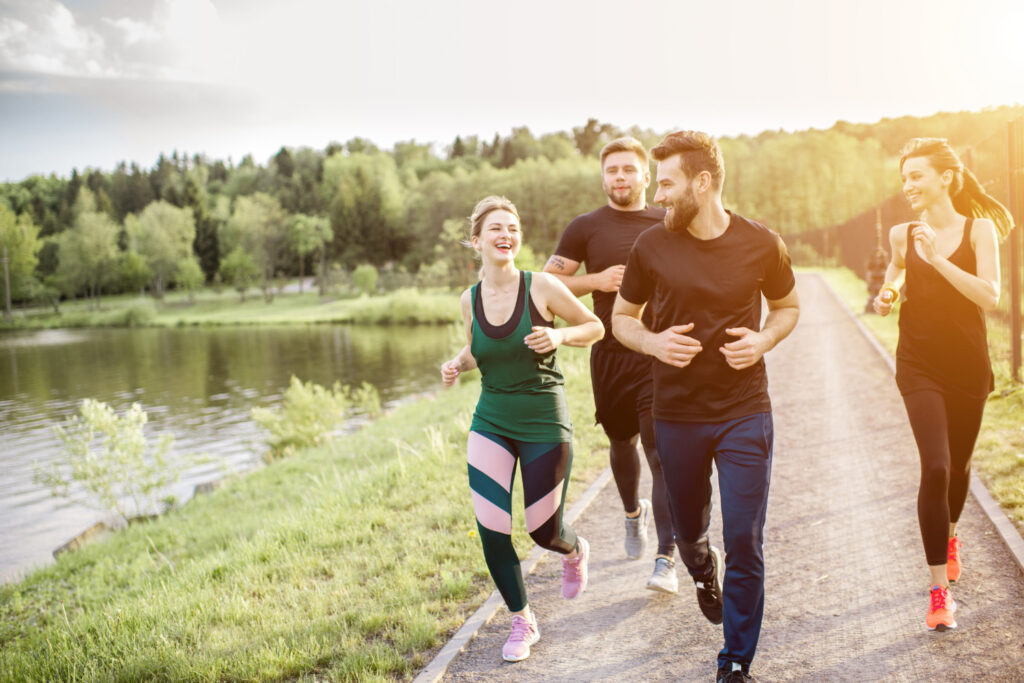
The great outdoors presents a picturesque platform for various forms of exercise, each contributing significantly to mental health and well-being. Recognizing the natural environment’s therapeutic qualities, activities such as hiking or engaging in team sports allow individuals to soak in the serenity of nature while fostering a sense of accomplishment and self-esteem:
- Connection with Nature: Being immersed in the natural world during activities like hiking has been shown to elevate mood and reduce feelings of stress and depression, a phenomenon often referred to as ‘nature therapy’.
- Team Sports and Camaraderie: Participating in team sports can enhance mental health by creating social bonds and instilling a sense of belonging and camaraderie, crucial factors in combating feelings of isolation.
- Mindfulness and Relaxation: Outdoor settings can encourage a mindful approach to exercise, where one is fully present in the moment, deepening the connection to the environment and promoting relaxation.
- Vitamin D Exposure: Exposure to sunlight during outdoor activities helps the body produce Vitamin D, which holds a beneficial impact on mood and cognitive function.
- Improved Concentration: Exercising in green spaces, as opposed to urban environments, has been associated with improved concentration and higher cognitive functioning.
8- Mind-Body Exercises: Tai Chi and Qigong for Mental Calmness and Stress Relief
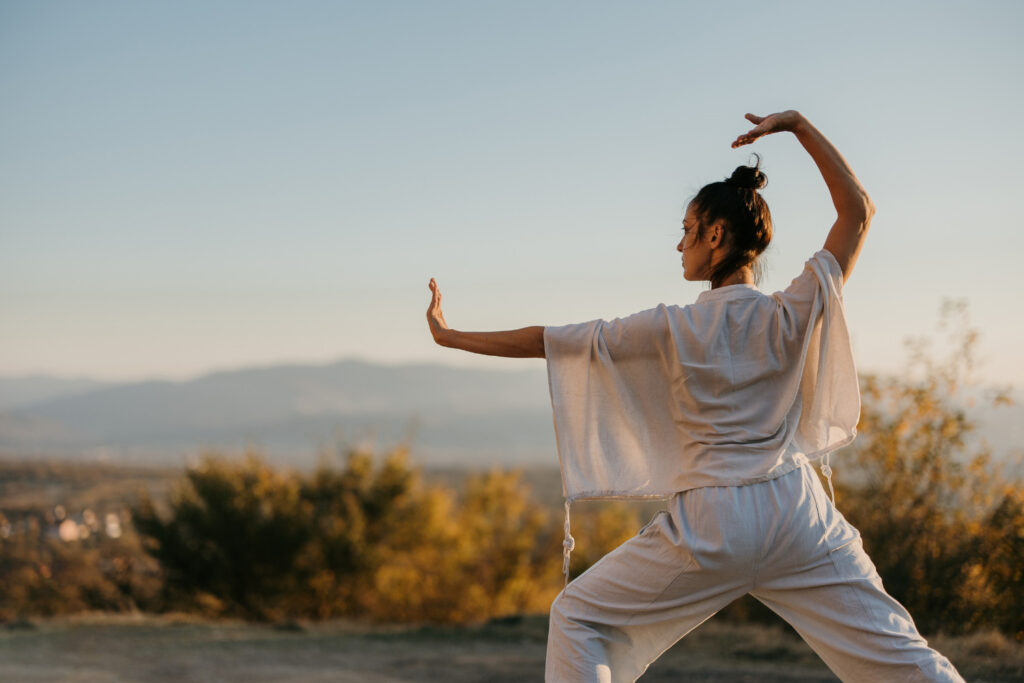
Mind-body exercises, such as Tai Chi and Qigong, are ancient practices that combine slow, deliberate movements, meditation, and breath control. The gentle flow of these exercises embodies a peaceful journey through both physical motion and mental stillness, promoting a tranquil state of mind and stress relief:
- Flowing Movements: The smooth and flowing movements of Tai Chi and Qigong have a calming effect on the nervous system, which helps in decreasing stress and anxiety levels.
- Breathing Techniques: Deep and mindful breathing is an integral part of these practices. It enhances relaxation and helps to control the body’s response to stress.
- Meditative State: As moving meditations, Tai Chi and Qigong encourage a meditative state that can lead to mental clarity, improved focus, and reduced mental chatter.
- Balance and Harmony: These exercises are rooted in the concept of balancing yin and yang—opposing elements within the body. This balance is believed to ease tension and support emotional equilibrium.
- Enhanced Mindfulness: The requirement to maintain steady, intentional movements fosters an increased sense of bodily awareness and mindfulness, which can translate into everyday life as a greater sense of calm and centeredness.
9- Boxing and Martial Arts: Cultivating Mental Toughness and Stress Reduction

Boxing and various martial arts disciplines go beyond physical training, contributing to mental resilience and stress relief. These rigorous forms of exercise push individuals to new heights of physical endurance and mental fortitude, fortifying the mind just as much as the body:
- Mental Toughness: Both boxing and martial arts often place individuals in high-pressure situations that simulate stress, teaching practitioners to remain calm and focused. This replicates real-life scenarios, building mental toughness and the ability to handle stressful circumstances.
- Stress Release: The intense physical exertion involved in these disciplines acts as an outlet for releasing tension. Hitting a heavy bag or engaging in sparring provides a physical release for pent-up stress hormones like cortisol.
- Discipline and Control: The structured nature of martial arts instills discipline, leading to improved self-control and the ability to manage emotional responses, which can be beneficial in reducing day-to-day stress.
- Confidence Building: As skills improve and personal goals are met, practitioners often experience an increase in self-esteem and confidence, which can translate into a more potent sense of control over stress and anxiety.
- Mindfulness: The practice of martial arts often involves a component of mindfulness or meditation, encouraging practitioners to focus on the present moment, which can be a powerful tool for stress management and mental well-being.
10- Guided Relaxation and Stretching: Easing Mental Tension through Physical Release
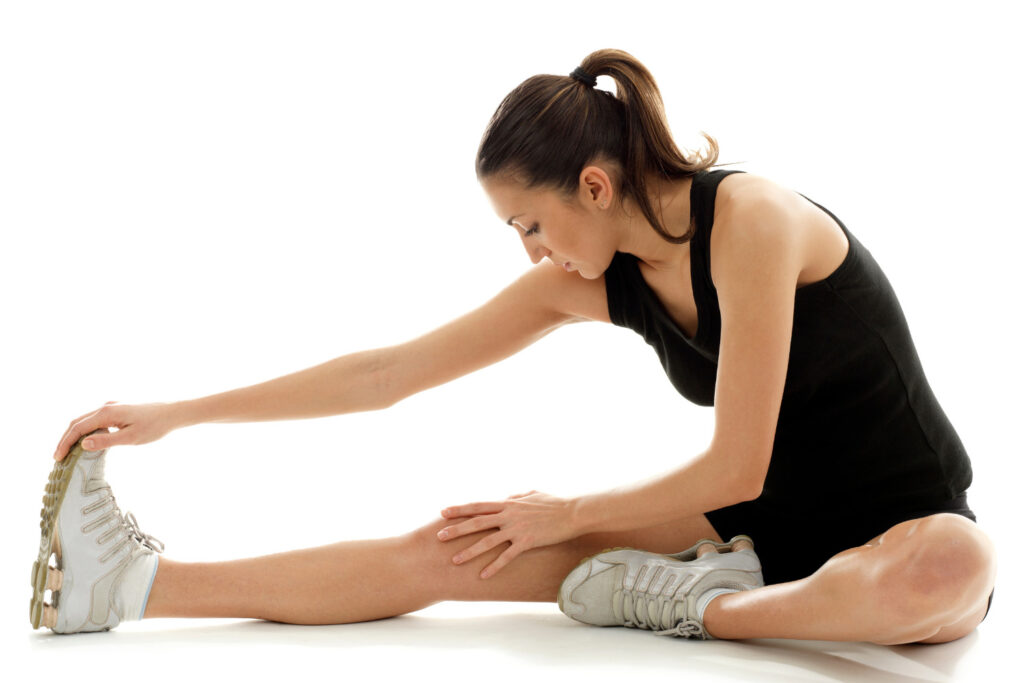
In the realm of mental health, guided relaxation and stretching exercises stand out as powerful techniques to alleviate mental tension and promote an overall sense of well-being. These practices intertwine physical movement with a focus on breathing, enabling the body to loosen up and the mind to unwind from the strains of daily life:
- Physical Release: Stretching helps in releasing muscle tension, which is often where the body holds stress. The act of stretching can lead to a reduction in the physical discomfort associated with mental tension.
- Guided Imagery: Coupled with visualization techniques, guided relaxation can transport a person’s mental focus to a tranquil setting, distancing them from immediate stressors and fostering a calm mental state.
- Breath Control: Proper breathing exercises promote relaxation of the central nervous system, encouraging a restful and meditative state which can help in managing stress and anxiety.
- Mind-Body Connection: These exercises enhance the connection between body and mind. As the body releases tension, the mind follows, leading to a harmonious state of relaxation and clarity.
- Routine and Consistency: Establishing a regular routine of relaxation and stretching provides a respite for the mind, signaling the body to enter a state of calmness, which over time, can reduce overall mental tension and stress levels.
Conclusion
In conclusion, integrating physical activity into our daily lives can offer remarkable benefits for mental health. Whether through the cardiovascular improvements gained from outdoor activities, the stress-relief found in mind-body exercises like Tai Chi and Qigong, the resilience built through the disciplined practice of boxing and martial arts, or the peaceful release afforded by guided relaxation and stretching, each modality offers a unique pathway to fortify our mental well-being. It’s clear that movement and mindfulness are potent allies in the quest for emotional balance and cognitive clarity. As we recognize the interconnectedness of our physical and mental states, embracing these various forms of exercise can lead to a more harmonious and stress-resilient life. Make space in your routine for these practices, and watch as your mental health benefits from the applied synergy of an active body and a nurtured mind.



